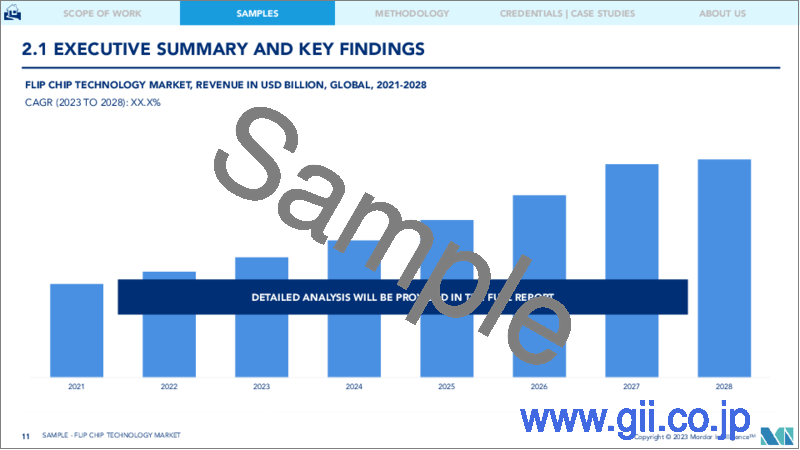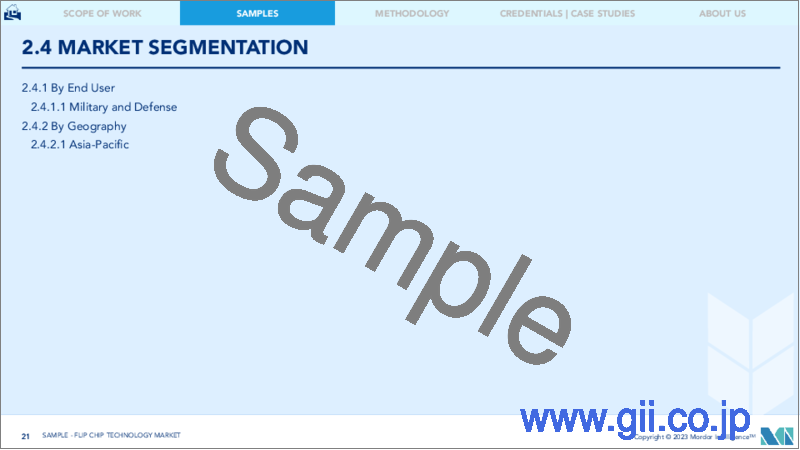|
|
市場調査レポート
商品コード
1190890
フリップチップ技術市場- 成長、動向、予測(2023年-2028年)Flip Chip Technology Market - Growth, Trends, and Forecasts (2023 - 2028) |
||||||
|
● お客様のご希望に応じて、既存データの加工や未掲載情報(例:国別セグメント)の追加などの対応が可能です。 詳細はお問い合わせください。 |
|||||||
| フリップチップ技術市場- 成長、動向、予測(2023年-2028年) |
|
出版日: 2023年01月18日
発行: Mordor Intelligence
ページ情報: 英文 120 Pages
納期: 2~3営業日
|
- 全表示
- 概要
- 目次
フリップチップ技術市場は、予測期間中に5.91%のCAGRで推移すると予想されます。
技術主導の市場であるため、メーカーは主にイノベーションとバンププロセスの新技術に注力しており、その結果、製造に必要な原材料の需要が増加しています。
主なハイライト
- このため、原料供給者の間でこの産業が急成長しています。他のパッケージング方式に比べ、信頼性、サイズ、柔軟性、性能、コストなどの主要な利点が、フリップチップ市場の成長を促す要因となっています。さらに、フリップチップの原材料、装置、サービスが入手可能であることも、予測期間中に市場を有利に推進させると予想されます。
- また、小型化、高性能化、I/Oの柔軟性向上など、競合手法と比較して多くの利点があることも、市場の成長に寄与しています。フリップチップの需要は、モバイル・ワイヤレス、コンシューマ・アプリケーション、ネットワーク、サーバ、データセンターなどの高性能アプリケーションで増加すると予想されます。フリップチップは、3次元集積やムーア方式以上の高度なSoC(System on Chip)を実現する上で、重要な促進要因の1つとなっています。
- MMIC(Monolithic Microwave IC)の力強い成長により、MMICはマイクロ波周波数(300 MHz~300 GHz)で動作するデバイスとして、市場は拡大しています。これらのデバイスは通常、マイクロ波混合、電力増幅、低ノイズ増幅、高周波スイッチングなどの機能を実行します。
- ファンアウトウエハーレベルパッケージングとエンベデッドダイは、フリップチップ市場で最も急速に台頭している技術の一つです。また、一部の著名なベンダーは、これらの技術への投資を増やし、それによって範囲を拡大しています。
- 例えば、2021年3月、Samsung ElectronicsはMarvellと提携し、強化された5Gネットワーク性能を提供する新しいシステムオンチップを共同開発しました。新たに発売されたチップは、サムスンのマッシブMIMOで使用されており、2021年第2四半期までにTier 1通信事業者の間で存在感を示すと予想されています。同様に、Mediatek, Inc.は、2020年11月に、Intel Enpirionの電源管理チップ資産を購入するために約8500万米ドルの買収契約に調印しました。
- COVID-19は、市場の成長に深刻な影響を与えています。これは、消費者の購買行動が、家電や自動車などの高級品から食料品などの必需品にシフトしたことによる。また、サプライチェーンにも影響を及ぼし、市場の成長を鈍化させました。
主な市場動向
軍需・防衛産業が市場成長を牽引
- 現代の軍事・防衛環境では、実証済みで信頼性が高く、拡張性の高い技術が必要とされています。センサーは、複雑な制御、測定、監視、実行を含む防衛エコシステム全体にソリューションを提供するため、これらの技術の重要な一部となっています。
- 軍事的な要件として、コンポーネントを50Kまで冷却する必要があるため、インジウムマイクロポンプをベースとした技術が開発されました。軍事システムのセンサーの数は増え続けており、そのため、軍事用コンピューティングプラットフォームにフリップチップ技術の要求が高まっています。
- レーダーは、パッケージングとアセンブリが実装を成功させる鍵です。レーダー・アプリケーションの増加に伴い、コストが非常に重要になります。車載用ミリ波レーダーとUAVでは、コストとパッケージングが重要な課題となっています。シングルチップのレーダーとマルチチャンネルT/Rモジュールは実現可能になってきています。
- 例えば,76~84 GHzの車載レーダ用 SiGe送受信フェイズドアレイチップが開発されました。このチップは,制御された崩壊チップ接続(C4)バンピングプロセスを使用し,低コストのプリント回路基板にフリップチップ化されており,送受信チェーン間で50 dBの絶縁を実現しています.本研究は、ミリ波帯の高性能FMCWレーダーにおいて、送受信同時動作のための最先端の複雑さを表現しています。
- 軍事アプリケーションの複雑化、高性能化、ピン数、消費電力、コストなどの要求により、パッケージング業界は、GPSやレーダー・アプリケーションの展開により、軍事・防衛用にフリップチップやウエハーレベル・ファンアウト・パッケージなどの高性能パッケージへの移行を進めています。この種のアプリケーションにフリップチップ技術を使用することは、多くのアプリケーションで、高密度電子機器を実現する信頼性の高いパッケージング技術であることが証明されています。
- 最近、革新的なRFソリューションのリーディングプロバイダーであるQorvoは、銅ピラーオンGaNフリップチップ技術の開発を進めるため、さらに3年間の契約を獲得しました。この国防総省(DoD)プログラムでは、高歩留まりの国内ファウンドリを設立し、銅フリップアセンブリプロセスを成熟させます。このプロセスは、スペースに制約のあるフェイズドアレイレーダーシステムやその他の防衛電子機器の垂直ダイスタッキングを可能にするものです。
中国が重要な市場シェアを占める
- 中国のパッケージング産業は、予測期間中に潜在的な成長を遂げることが期待されています。IC部品の需要が旺盛なため、より高度な集積度とI/O接続数を提供する先進的なパッケージングソリューションの展開が拡大しています。
- 中国政府のイニシアチブである「Made in China 2025」は、2030年までに半導体産業の生産高を3050億米ドルに達し、国内需要の80%を満たすことを目標としています。中国は、技術戦争が勃発する中で、チップ産業を強化しています。米国と中国の貿易戦争、中国企業が米国の技術から切り離される恐れがある(Huaweiのような大手企業として)ことが、中国の半導体産業の推進を後押ししています。
- フリップチップ市場にはバンピングとアセンブリが含まれるが、特に12インチCuピラーでは、中国企業によるバンピング能力の増強が非常に進んでいます。先進パッケージングプレーヤーの90%以上が300mmウエハーのバンピング能力を有しています。2019年には中国の電子企業であるJiangsu Changjiang Electronics Technology(JCET)がウエハーの量産バンプを開始しました。同社は、新たに12インチのウエハーバンピングラインを導入し、量産に移行しました。生産量はすでに中国のJCETの顧客に出荷されており、さらにいくつかのデバイスメーカーがこのラインの出荷を承認しています。
- COVID-19の大流行により、中国では長期にわたる操業停止により、すべての製造業や拠点が影響を受け、フリップチップ技術市場に影響を及ぼしています。さらに、中国の検査・パッケージング企業は、ハイエンドパッケージ技術(フリップチップ、バンピングなど)やより高度な(ファンイン、ファンアウト、2.5Dインターポーザー、SiPなど)処理能力の獲得を続けています。
- JCET、TSHT、TFMEなど中国のサービスプロバイダーは、技術開発とM&Aの両方が進んでいるため、今年の収益実績は業界平均を上回る二桁の成長率になると予測されます。
競合情勢
フリップチップ技術市場は、自動車、産業、家電の各分野でエンドユーザーが増加しているため、細分化されています。予測期間中、市場は安定的に成長すると予想されます。市場の既存プレイヤーは、5G通信、高性能データセンター、小型電子機器などの新技術に対応することで、競争力を維持しようと努めています。市場における最近の開拓は以下の通りです。
- 2021年11月- 半導体パッケージングとテストサービスの大手プロバイダーであるAmkor Technology Inc.(NASDAQ:AMKR)は、ベトナムのバクニンに最新鋭のスマート工場を建設することを計画しました。新工場の第1期は、世界の大手半導体・電子機器製造企業に先進的なシステムインパッケージ(SiP)アセンブリとテストソリューションを提供することに焦点を当てる。
その他の特典
- エクセル形式の市場予測(ME)シート
- アナリストによる3ヶ月間のサポート
目次
第1章 イントロダクション
- 調査の前提条件と市場の定義
- 調査対象範囲
第2章 調査手法
第3章 エグゼクティブサマリー
第4章 マーケットインサイト
- 市場概要
- 産業の魅力- ポーターのファイブフォース分析
- 供給企業の交渉力
- 買い手の交渉力
- 新規参入業者の脅威
- 代替品の脅威
- 競争企業間の敵対関係
- 産業バリューチェーン分析
第5章 市場力学
- 市場促進要因
- ウェアラブルデバイスの需要拡大
- MMIC(Monolithic Microwave IC)アプリケーションの力強い成長
- 市場の課題
- 技術に関連するコスト上昇
第6章 技術スナップショット
第7章 市場セグメンテーション
- ウエハーバンピングプロセス別
- 銅ピラー
- 錫-鉛共晶はんだ
- 鉛フリーはんだ
- 金スタッドバンピング
- パッケージング技術別
- BGA(2.1D/2.5D/3D)
- CSP
- 製品別(定性分析のみ)
- メモリ
- 発光ダイオード
- CMOSイメージセンサ
- SoC
- GPU
- CPU
- エンドユーザー別
- 軍事・防衛
- 医療・ヘルスケア
- 産業分野
- 自動車
- コンシューマーエレクトロニクス
- 通信分野
- 地域別情報
- 中国
- 台湾
- 米国
- 韓国
- マレーシア
- シンガポール
- 日本
第8章 競合情勢
- 企業プロファイル
- Amkor Technology Inc.
- UTAC Holdings Ltd
- Taiwan Semiconductor Manufacturing Company Limited
- Chipbond Technology Corporation
- TF AMD Microlectronics Sdn Bhd
- Jiangsu Changjiang Electronics Technology Co. Ltd
- Powertech Technology Inc.
- ASE Industrial Holding Ltd(Siliconware Precision Industries Co. Ltd)
第9章 投資分析
第10章 市場の将来
The flip chip technology market is expected to register a CAGR of 5.91% over the forecast period. Being a technologically driven market, manufacturers are mainly focusing on innovations and on new technologies for the bumping process, which, in turn, is increasing the demand for raw materials required for manufacturing.
Key Highlights
- This leads to rapid growth in this industry among raw material suppliers. Its primary advantages over other packaging methods, namely, reliability, size, flexibility, performance, and cost, are the factors driving the growth of the flip-chip market. The availability of flip-chip raw materials, equipment, and services is further expected to drive the market lucratively during the forecast period.
- Moreover, the growth of the market is attributed to its numerous advantages, such as smaller size, higher- performance, and enhanced I/O flexibility over its competitive methodologies. The demand for flip-chip is expected to rise in mobile and wireless, consumer applications, and other high-performance applications such as networks, servers, and data centers. In terms of 3D integration and more than the Moore approach, the flip-chip is one of the key driving factors and helps enable sophisticated SoC (system on chip).
- Due to the strong growth in MMIC (monolithic microwave IC), the market is growing, as MMICs are devices that operate at microwave frequencies (300 MHz to 300 GHz). These devices typically perform functions such as microwave mixing, power amplification, low-noise amplification, and high-frequency switching.
- Fan-out wafer-level packaging and embedded die are some of the fastest emerging technologies for the flip-chip market. Also, some of the prominent vendors are increasing their investment in these technologies, thereby expanding their scope.
- For instance, in March 2021, Samsung Electronics partnered with Marvell to jointly develop a novel system-on-a-chip to offer enhanced 5G network performance. The newly launched chip finds usage in Samsung's massive MIMO and is anticipated to see its presence among Tier One operators by Q2 2021. Similarly, Mediatek, Inc., in November 2020, inked an acquisition deal of approximately USD 85 million to purchase the power management chip assets of Intel Enpirion.
- COVID-19 has severely affected the market growth. This is due to the shifting of consumer purchasing behavior towards essential goods such as groceries from luxury goods such as consumer electronics and vehicles. The supply chain was also affected, thus slowing down the market growth.
Key Market Trends
The Military and Defense Industry to Drive the Market Growth
- Modern military and defense environments require proven, reliable, and scalable technologies. Sensors are a critical part of the technologies, as these provide solutions to the whole defense ecosystem, including complex controls, measurements, monitoring, and execution.
- For military requirements, the need to cool components down to 50 K has led to the development of a technology based on indium micropumps. The sensor content of military systems continues to grow, thereby driving requirements for flip chip technology in military computing platforms.
- For any radar, packaging and assembly are the keys to a successful implementation. As radar applications proliferate, cost becomes critical. For millimeter-wave automotive and UAV, cost and packaging are being addressed. Single-chip radars and multi-channel T/R modules are becoming feasible.
- For example, a SiGe transmit-receive phased-array chip for automotive radar applications at 76 to 84 GHz has been developed. The chip uses a controlled collapse chip connection (C4) bumping process and is flip-chipped onto a low-cost printed circuit board, achieving 50 dB isolation between the transmit and receive chains. This work represents state-of-the-art complexity for a high-performance FMCW radar at millimeter-wave frequencies, with simultaneous transmit and receive operation.
- Due to the increasing complexities and higher performance, pin count, power, and cost requirements of military applications, the packaging industry is moving toward high-performance packages, such as flip-chip or wafer-level fan-out packaging, for military and defense by deploying GPS and radar applications. The use of flip-chip technology for this type of application has proven itself, in many applications, to be a reliable packaging technology to achieve high-density electronics.
- Recently, Qorvo, a leading provider of innovative RF solutions, was awarded a three-year contract further to advance the development of copper-pillar-on-GaN flip-chip technology. This Department of Defense (DoD) program will create a high-yield domestic foundry to mature the copper flip assembly process, which enables vertical die stacking in space-constrained phased array radar systems and other defense electronics.
China Occupies the Significant Market Share
- The packaging industry in China is expected to register potential growth during the forecast period. There is a strong demand for IC components, which has expanded the deployment of advanced packaging solutions that offer higher levels of integration and higher numbers of I/O connections.
- The Chinese government's initiative of "Made in China 2025" aims to make its semiconductor industry reach USD 305 billion in output by 2030 and meet 80% of domestic demand. China is ramping up its chip industry amid a brewing tech war. United States-China trade war and the threat that Chinese firms could be cut off from American technology(as major firms like Huawei) are boosting China's push for its semiconductor industry.
- The flip-chip market includes bumping and assembly, and there is enormous ramping of bumping capacity by Chinese players, particularly in the 12" Cu pillar. More than 90% of advanced packaging players have 300 mm wafer bumping capability. In 2019, Chinese electronics company Jiangsu Changjiang Electronics Technology (JCET) started high-volume wafer bumping. The company has moved into volume production with its new 12-inch wafer bumping line. Production volumes are already being shipped to China-based JCET customers, with several additional device manufacturers qualifying the line for shipments.
- Due to the COVID-19 pandemic, all the manufacturing industries and bases are affected in China due to the long-lasting shutdown in the country, thereby affecting the flip-chip technology market. Moreover, the Chinese testing and packaging companies continue to gain processing capacity for high-end packaging technologies (e.g., flip-chip and bumping) and more advanced (e.g., fan-in, fan-out, 2.5D interposer, and SiP).
- Owing to the progress in both technology development and merger and acquisitions, Chinese service providers, such as JCET, TSHT, and TFME, are projected to rise above the industry's average in their revenue performances this year with double-digit growth rates.
Competitive Landscape
The flip chip technology market is fragmented due to the growing number of end users in automotive, industrial, and consumer electronics. The market is expected to grow at a fair steady rate over the forecast period. The existing players in the market are striving to maintain a competitive edge by catering to newer technologies, such as 5G telecommunication, high-performance data centers, compact electronic devices, etc. Some of the recent developments in the market are -
- November 2021 - Amkor Technology Inc. (NASDAQ: AMKR), a leading provider of semiconductor packaging and test services, planned to build a state-of-the-art smart factory in Bac Ninh, Vietnam. The first phase of the new factory would focus on providing advanced system in package (SiP) assembly and test solutions to the leading global semiconductor and electronic manufacturing companies.
Additional Benefits:
- The market estimate (ME) sheet in Excel format
- 3 months of analyst support
TABLE OF CONTENTS
1 INTRODUCTION
- 1.1 Study Assumptions and Market Definition
- 1.2 Scope of the Study
2 RESEARCH METHODOLOGY
3 EXECUTIVE SUMMARY
4 MARKET INSIGHTS
- 4.1 Market Overview
- 4.2 Industry Attractiveness - Porter's Five Forces Analysis
- 4.2.1 Bargaining Power of Suppliers
- 4.2.2 Bargaining Power of Buyers
- 4.2.3 Threat of New Entrants
- 4.2.4 Threat of Substitute Products
- 4.2.5 Intensity of Competitive Rivalry
- 4.3 Industry Value Chain Analysis
5 MARKET DYNAMICS
- 5.1 Market Drivers
- 5.1.1 Increasing Demand for Wearable Devices
- 5.1.2 Strong Growth in MMIC (Monolithic Microwave IC) Applications
- 5.2 Market Challenge
- 5.2.1 Higher Costs Associated with the Technology
6 TECHNOLOGY SNAPSHOT
7 MARKET SEGMENTATION
- 7.1 By Wafer Bumping Process
- 7.1.1 Copper Pillar
- 7.1.2 Tin-Lead Eutectic Solder
- 7.1.3 Lead Free Solder
- 7.1.4 Gold Stud Bumping
- 7.2 By Packaging Technology
- 7.2.1 BGA (2.1D/2.5D/3D)
- 7.2.2 CSP
- 7.3 By Product (Only Qualitative Analysis)
- 7.3.1 Memory
- 7.3.2 Light Emitting Diode
- 7.3.3 CMOS Image Sensor
- 7.3.4 SoC
- 7.3.5 GPU
- 7.3.6 CPU
- 7.4 By End User
- 7.4.1 Military and Defense
- 7.4.2 Medical and Healthcare
- 7.4.3 Industrial Sector
- 7.4.4 Automotive
- 7.4.5 Consumer Electronics
- 7.4.6 Telecommunications
- 7.5 By Geography
- 7.5.1 China
- 7.5.2 Taiwan
- 7.5.3 United States
- 7.5.4 South Korea
- 7.5.5 Malaysia
- 7.5.6 Singapore
- 7.5.7 Japan
8 COMPETITIVE LANDSCAPE
- 8.1 Company Profiles*
- 8.1.1 Amkor Technology Inc.
- 8.1.2 UTAC Holdings Ltd
- 8.1.3 Taiwan Semiconductor Manufacturing Company Limited
- 8.1.4 Chipbond Technology Corporation
- 8.1.5 TF AMD Microlectronics Sdn Bhd
- 8.1.6 Jiangsu Changjiang Electronics Technology Co. Ltd
- 8.1.7 Powertech Technology Inc.
- 8.1.8 ASE Industrial Holding Ltd (Siliconware Precision Industries Co. Ltd)




